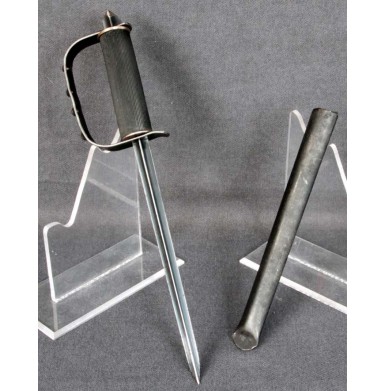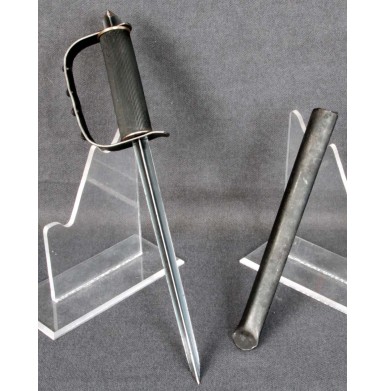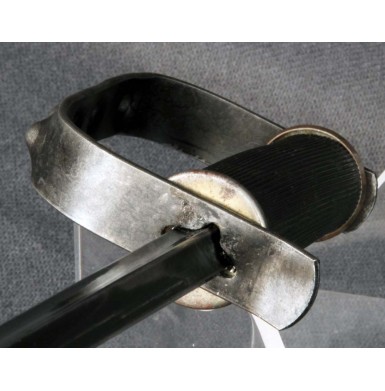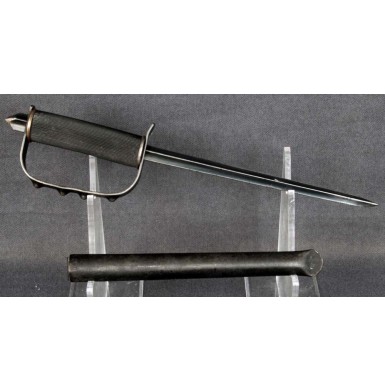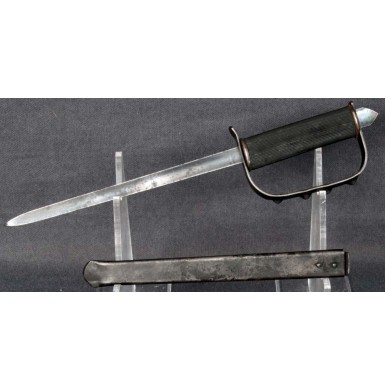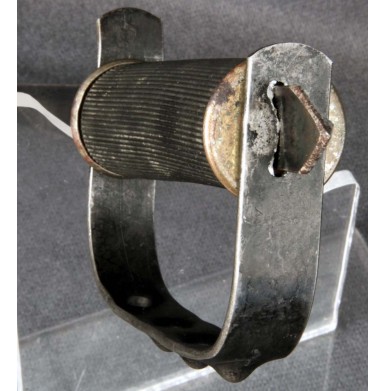This is a FINE example of the relatively scarce OSS Drop Knife. The OSS (Office of Strategic Services) was formed by the US Government during World War II, as an intelligence agency that was tasked with performing and coordinating espionage activities behind enemy lines. The agency was the predecessor of today’s Central Intelligence Agency (CIA). The OSS not only coordinated and assisted local resistance fighters, but also provided weapons from time to time. Some of the more commonly known OSS weapons are the single shot “Liberator” .45 ACP pistol and the “Sterile Drop Knife”. While there is some dispute among researchers as the accuracy of the OSS association for these inexpensively produced “knuckle” fighting knives, but they have been referred to by this name by the most notable of US edged weapons researchers and authors including M.H. Cole, Michael Silvey, Homer Brett and Robert Buerlein. One way or the other the knives were produced in the US during World War II and appear to have been intended to provide cheap weapons to resistance fighters.
The OSS Drop Knife was manufactured in two patterns. The first was made from surplus US M-1873 Trapdoor rifle bayonets, and used their metal scabbard bodies as well. The second pattern used surplus M-1913 Patton Saber blades. The knives made from bayonets were built using the original bayonet blade, with the addition of a stamped metal, D-shaped handguard and a hilt that utilized rubber hosing for the grip. The knives were unmarked (thus the “sterile” nomenclature), and were intended to be “dropped” behind enemy lines to arm local resistance fighters. The knives had blades that varied between 8 ““ and 9” and the knives had an overall length of about 14”. The knives were essentially inexpensive copies of the US M-1917 Trench Knife. The bayonet blade extended through the grip, forming the hilt, and extended out the back of the D-guard, where it was shaped into a point to form a skull crusher. The original metal scabbards were shortened and then crimped closed, and the scabbard was intended to be suspended from a leather belt frog.
This OSS Drop Knife is in FINE condition. The knife retains about 70%-80% of the original bluing on the bayonet blade, with some fading and scattered patches of minor oxidation and light pinpricking. Most of the fading and light oxidation is on the face of the bayonet blade, with the flutes retaining more of the original finish. The stamped D-guard has the majority of its original black paint, and four “knuckle” ridges stamped into it. The guard has a couple of minor dings in it, but is otherwise solid with no major damage. The grooved rubber hose grip around the round metal hilt is in fine shape with no rips, tears or visible damage. The end of the bayonet that projects through the stamped metal D-guard has been fashioned into a skull crusher, as is typical of these knives. The blade is 8 ““ in length and the overall length of the knife is about 14 1/8”, from the tip of the skull crusher to the tip of the knife. The original scabbard is present with the knife, but the leather frog is missing. The scabbard is 9 ““ in length and was made by cutting down an original metal M-1873 Trapdoor bayonet scabbard and then crimping the cut off end down to a sort of duck billed shape. The scabbard retains about 80% of the period-applied black paint, with only some light scuffing and minor loss. The scabbard is free of any dings or dents and the knuckle knife fits it perfectly.
Overall this is a really wonderful condition example of a classic American fighting knife made during World War II from surplus bayonets. These knives are relatively scarce and are a great example of the ingenious way in which many obsolete bayonets and swords were altered into useful weapons for American troops and allies. The knife would look equally good in a display of edges weapons that focuses on the re-worked and remanufactured knives of World War II, a display of OSS and early CIA weapons and memorabilia or any collection of American fighting knives of the World War II era. The knife is in great shape, displays wonderfully and its interesting construction and design is sure to spark many questions when the weapon is displayed.
SOLD
